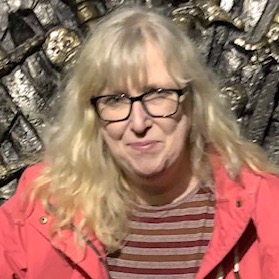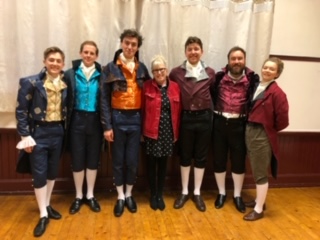Chris' Story
Burntwood, Staffordshire
Historical costume maker, who loves spending time with her grandson and having a good laugh
Procedure Details:
Age at treatment: 54 years
Doctor name: Mr. Babu Naidu
Hospital: Heartlands Hospital, Birmingham
Date of procedure: November 2017

Life Before Zephyr Valves:
I worked as a history teacher in a secondary school. It was a job I absolutely loved. My life was wonderful.
I was initially diagnosed with asthma when I was 30 after living in damp conditions while studying at university. More than a decade later, during an annual check-up for my asthma, the practice nurse noticed that something wasn’t quite right. She sent me to back my GP who arranged further tests, and following an x-ray it was confirmed that I had hyperinflation. I didn’t know what it meant in anything other than historical terms. The doctor explained that I couldn’t breathe out carbon dioxide and I was diagnosed with COPD that year in 2004.
My condition was stable for many years but my lung function was poor and deteriorated over time. As my COPD developed I found it harder to do everyday tasks. It really slowed me down. I needed to take regular breaks and I couldn’t manage like before. I had to give up teaching and took early retirement. It really broke my heart.
I took up sewing and started my own business. As my health deteriorated I was sent to the team at the Queen Elizabeth (QE) Hospital. There I learnt that I had a rare disease called Alpha-1-antitrypsin deficiency (AATD), a genetic condition which can cause lung and liver problems. The doctor explained that the condition made me more vulnerable to the effects of smoke inhalation or materials such as dust or fumes but I was turned down for a lung transplant because I was too well.
I may have developed emphysema for some time but it was such a slow and gradual worsening of my condition that I didn’t notice.
At the end of 2016 I was rushed into hospital and they found that I had bullae in my chest. It was then that my condition really took a turn for the worse. I was on oxygen 24/7 and confined to a wheelchair because I couldn’t walk more than three steps. When my daughter left to go to university I couldn’t get any help and struggled to look after myself. I couldn’t go out and socialize and I wasn’t able to look after my grandson. It was the worst year of my life.
My condition was awful and I hit an all-time low. I wasn’t able to cook or feed myself. It was so debilitating. My consultant recommended that I have the Zephyr Valve treatment and referred me to Professor Naidu at Heartlands Hospital in Birmingham.
Life After Zephyr Valves:
Since having Zephyr Valve treatment, my life has changed dramatically. It’s been a complete transformation. I work for myself now making historical costumes. I am back to being independent. I won’t be running a marathon any time soon but my life is so much better.
I’d always wanted to be able to look after my grandson on my own and I’ve been able to do that since having treatment. It’s been wonderful.
The procedure was carried out in July 2017 and went swimmingly well but when I went home I didn’t feel any different. When I was booked in for a replacement I was worried that they would only remove the existing valve.
When I returned in November 2017 they not only removed the valve but put two new valves in. I was delighted. I knew it had worked straight away because I no longer needed to use my wheelchair. A week later I was in the supermarket shopping, something I hadn’t been able to do by myself for a year. Suddenly just before Christmas I was independent again. It was like a miracle. I felt a million times better.
As soon as I had the procedure I went back to work and I’ve never looked back. I started my own business channeling my passion for history by making period costumes. It helps that I can work at my own pace and sit at the sewing machine. I couldn’t even walk three steps before having valve treatment and now I’ve got my life back.
I’m really looking forward to going out and seeing my grandchildren again once the shielding restrictions are lifted.
My message to anyone suffering with COPD and emphysema is if you are eligible for the Zephyr Valves, go for it!

What is the Zephyr Valve procedure?
The Zephyr Valve is intended for the treatment of patients with severe emphysema – a form of COPD. A physician uses a bronchoscope to place on average 4 tiny valves in the airways to block off the damaged areas of the lungs so air no longer gets trapped there. No cutting or incision is required and the procedure is usually completed in under an hour.
The valve placement allows the healthier parts of the lungs to expand and relieves the pressure on the diaphragm, which decreases shortness of breath and makes breathing easier. Patients report being able to take full breaths immediately after the procedure and within a few days are back to doing everyday tasks with ease.
